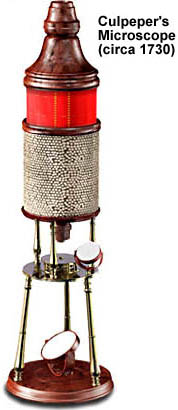The Culpeper-Style Microscope
Between the years of 1725 and 1730, British instrument maker and microscope designer Edmund Culpeper produced what was to become a very popular microscope design, as illustrated below.

Culpeper took over a Walter Hayes's scientific instrument business in 1685, after Hayes's death, and he stayed in business until 1738. Today a great number of his microscopes have survived due to their popularity in the eighteenth century.
Departing for the pillar-style microscopes developed by Hooke and Marshall, the tripod design of Culpeper utilizes the same motif of Campani-style microscopes. The basic Culpeper design consisted of a dual set of brass tripods, one set of which was mounted on a wooden base and connected to the stage. The other set of tripods was rotated sixty degrees with respect to the first set and secured the microscope body to the stage (see the illustration). Focusing was achieved by sliding the telescopic microscope body in and out of a support tube. In the case of the microscope illustrated above, the support tube was made from wood (often cardboard in very early models) and covered with dyed rayskin. The inner body tube is also wood and covered with red vellum with panels of tooled gold lines.
The eyepiece holds a bi-convex eye lens and is constructed of wood turned with a lathe and polished before staining. On the base of the microscope is a concave mirror that serves to concentrate (much like a condenser) and reflect illumination from a candle or the sun onto the specimen for transmitted microscopy. Culpeper provided a bi-convex single-lens stage illuminator for reflected light microscopy of opaque specimens.
Objectives were provided in several different magnifications (from about 30x to over 250x) and were mounted in a brass cell or button that could be screwed onto the nose piece of the microscope. These lenses suffered from extreme chromatic and spherical aberration, but Culpeper helped to alleviate this with the addition of small diaphragms placed behind the objective. The microscope was able to achieve resolutions of near five microns with the most powerful objectives.
Culpeper's instruments were inexpensive and easy to construct, but they were also very cheap in quality compared to other instruments of the day. Some of his later microscopes (as shown above) did use brass instead of cardboard, but as a whole Culpeper's microscopes represented regression in microscope design. The microscope could not be inclined, making it uncomfortable to use and the split support legs aggravated access to the stage and made sample positioning difficult. Another down side of this microscope is the crude focusing mechanism that lacked an accurate fine focus adjustment.
BACK TO EIGHTEENTH CENTURY MICROSCOPES
